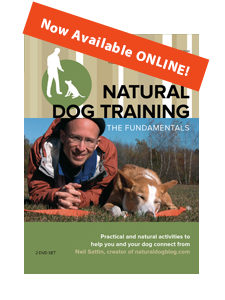While crate training isn't a "natural dog training" technique, per se, it is a technique that I often recommend to clients, so I wanted to spend a few moments discussing it here on the blog. Using a crate is handy for helping you and your dog with housebreaking, separation anxiety, chewing, craziness upon the arrival of guests, and essentially most "indoor" dog behavior situations. I'm going to address what's good about crates, what to avoid in your crate thinking, and an outline for how to crate train your dog. Finally, I'll offer some insights into how you can integrate the crate into your Natural Dog Training routine.
What's good about using a crate
- You provide a safe place for your dog to relax. Life in human world can be pretty stressful for a dog. A nice, dark, cozy crate can be the perfect retreat for your dog - especially if you have children running around and making the home environment a little more hectic.
- Housetraining made easy. While a crate isn't essential for housebreaking, it makes your job a whole lot EASIER. For this purpose, the best crate is just big enough for your dog. If a crate is too big, then your dog will be able to pee/poop in a corner of the crate and retreat to another side of the crate. That would be counterproductive. Part of what inhibits a dog's desire to excrete in the crate is the smallness of the environment and their inability to escape the results of a "mistake".
- Structure. Often people have a fear of confining their dog to a crate, because they imagine how it would feel to be "in a cage" all day. That's tough for a human to take, but the structure of crate-time (when a dog is relaxed, sleeping, gnawing on bones, and in a quiet place) vs. non-crate time (when a dog is outside playing, or otherwise in the company of their human companions) gives shape to a dog's day. They develop a feeling for the rhythm of the day, and are much less likely to experience separation anxiety. You're also keeping your dog out of trouble - Sparky won't be able to chew up your favorite slippers while you're at work if Sparky can't get to your favorite slippers in the first place.
Things to avoid in your crate training
- Crate as punishment. The crate should be a pleasant place for your dog. Do not send your dog to the crate as a means of punishing your dog. Part of this is changing your ATTITUDE as well. For instance, let's say that you have a bunch of guests over, and your dog is really hyped up and excited. A punitive attitude would throw the dog into their crate, thinking "That'll teach you. Spend some time alone until you can get it together!" while a more positive attitude would be "I'm just going to put you in your crate so that you can relax while we have all these crazy people over at the house." You need to develop the perspective of doing your dog a favor when you put your dog in the crate - so if you're looking for a way to scold, start thinking about how to redirect what's going on with your dog instead.
- A wide open wire crate. In order for a crate to truly become your dog's den, it needs to seem more den-like. Some people think they're doing their dogs a favor by getting them a wire crate and keeping them out in the open, so that they can "still experience the world around them and avoid feeling closed in". The end result of this kind of crate is a dog that feels exposed and vulnerable when they're crated. Instead, your crate should be small, dark, and cozy. Tuck the crate away, so that it truly becomes a safe retreat for your dog.
The basics of cratetraining
Essentially, what you're after is a dog who hangs out happily in the crate. In order to do that you have to do two separate things:
- Have quality time with your dog when they're not in the crate. Your job is to do your training work (push, tug, fetchtug, boxwork, etc.) consistently. In an ideal world, you'd do about 20 minutes of training followed by a long walk with your dog BEFORE you put your dog in the crate. After your dog has spent time in the crate, upon letting your dog out you should immediately head outside for some more training/play and a walk.
- Create positive associations with the crate. Have a tasty meatbone in the crate for your dog to chew on. Always give your dog treats when they go into the crate. Use half your dog's meals for training, and then feed them the other half IN THE CRATE (put the food bowl in the back of the crate).
If you don't treat going into the crate as a very big deal, then your dog will be less likely to experience it as a big deal. So be nonchalant, throw treats in, let your dog go in after the treats and come back out freely. Don't worry about closing the door right away (unless you have to out of necessity). Just take it slow, and once your dog is entering the crate without hesitation you can close the door. Give your dog a chance to settle in the crate and then, once they're relaxed, you can let them out at your convenience. Gradually increase the amount of time that your dog is in the crate.
When you return home from being away, allow your dog some time to relax before you open the crate and head (immediately) outside to play. In this manner you're helping maintain a calm emotional environment associated with your absence (and return) - and you reinforce for your dog the lesson that feeling CALM leads to interaction with you. Were you to immediately head over to the crate and let an excited dog out upon your arrival, you would be associating a different, more energized emotional state with your dog's experience in that moment - and that would interfere with your aim of having your dog be as relaxed as possible when indoors (and specifically when they're in the crate).
Incorporating Natural Dog Training
We've already discussed the importance of sandwiching crate time in between training and play time. One way that you can incorporate the crate directly into your training is to treat the crate like the "box" in our box training exercises. During a training session, you can use treats to entice your dog to "Kennel Up!" (or whatever command you choose), and then use your body language/hand position to encourage a "Down" in the crate. You will be teaching your dog an energized "down" within the crate, which will ultimately help them feel more grounded/settled should they feel energized during their crate time. You're teaching your dog that "lying down" is a healthy outlet for their energy. As you incorporate "Stay" into your training regimen you can use that command as you train in conjunction with the crate as well. As an example of a practical application of this training, when guests come over you might lead your dog to the kennel, have them lie down and stay there for 10 or 15 minutes, long enough to settle down and facilitate a more relaxed greeting of the new arrivals.
The crate can be a positive, useful tool for you and your dog. In the dog's world, you're providing a safe, closed-in, den-like environment for them to hang out away from the hustle and bustle of the rest of the world. It's a perfect place for them to decompress while you're away, and potentially a relaxing place for them to be when things in the house get a little too chaotic. Just make sure that your dog's crate time is balanced out with some Natural Dog Training-inspired activity. Feel free to ask if you have any specific questions. And a reminder - I am going to be publishing the fourth edition of the "all about dog training" blog carnival on Dec. 17th, so the deadline to submit an article is Sunday, December 16th. If you or any trainers you know have some good stuff, please send it my way.





Trackbacks/Pingbacks